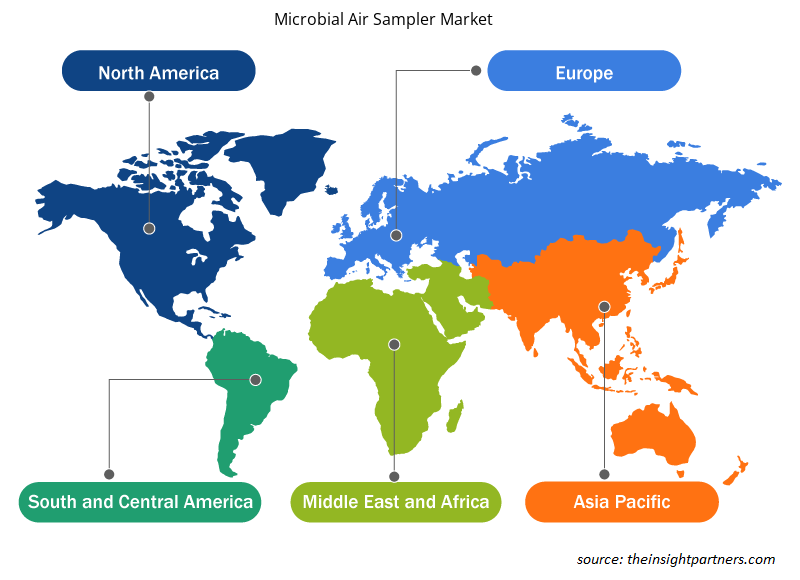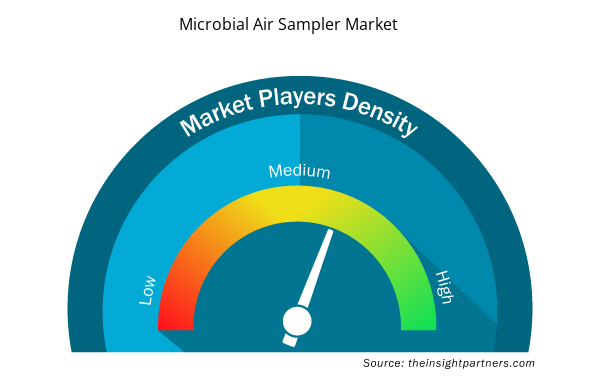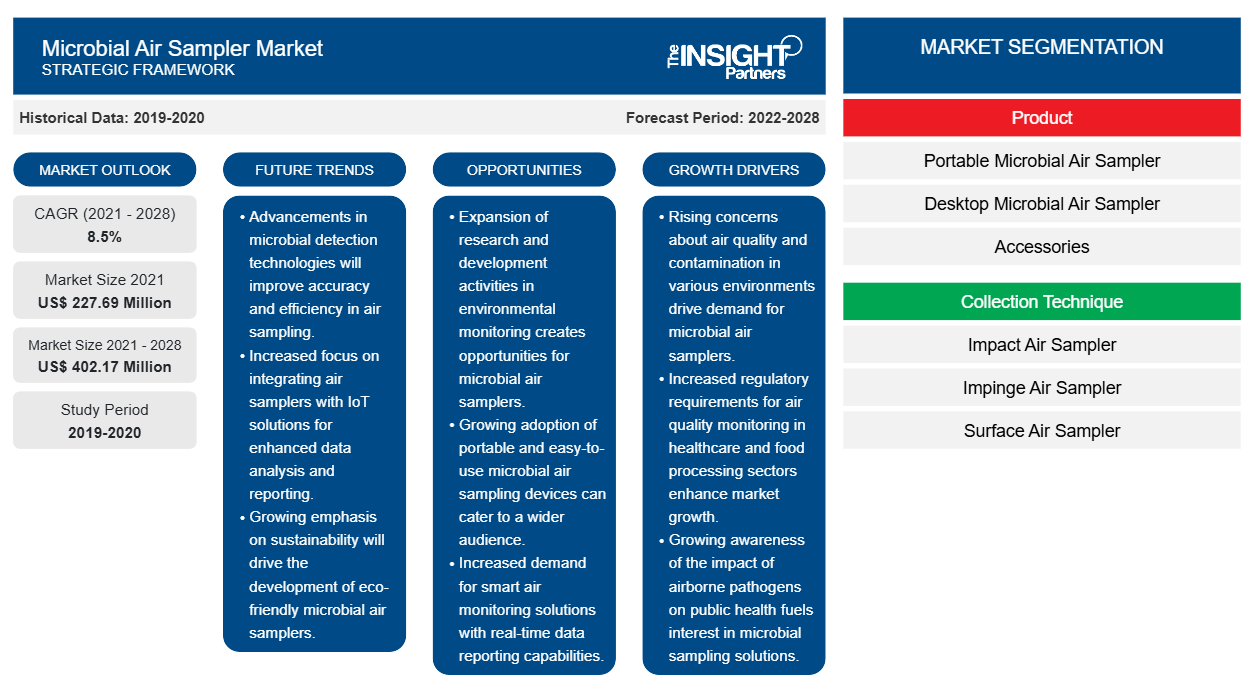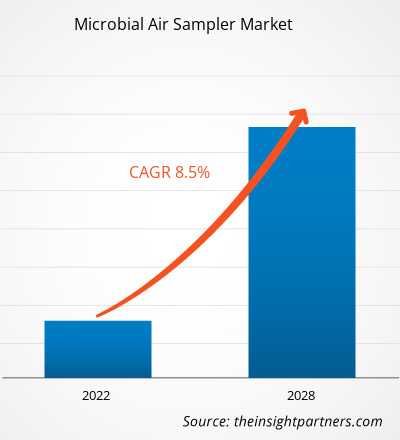Der Markt für mikrobielle Luftprobenehmer wird voraussichtlich wachsen von227,69 Millionen US-Dollar im Jahr 2021 auf 402,17 Millionen US-Dollar im Jahr 2028; es wird geschätzt, dass von 2021 bis 2028 eine durchschnittliche jährliche Wachstumsrate (CAGR) von 8,5 % verzeichnet wird.
Ein mikrobieller Luftprobenehmer ist ein Gerät zur Untersuchung mikrobiologischer Partikel in der Luft oder in einer kontrollierten Umgebung. Ein mikrobieller Luftprobenehmer funktioniert, indem er für einen bestimmten Zeitraum Luft in oder auf ein Sammelmedium presst. Die erhaltene Kultur wird dann inkubiert und das Vorhandensein der Mikroben in der Luft wird qualitativ und quantitativ bewertet. Er kann zur mikrobiologischen Luftuntersuchung bei Inspektionen auf mikrobiologische Kontamination in Reinräumen und hygienisch sensiblen Produktionsbereichen sowie an verschiedenen Geräten in der Lebensmittelindustrie verwendet werden.
Das Wachstum des Marktes für mikrobielle Luftprobenentnahmegeräte ist hauptsächlich zurückzuführen aufauf Faktoren wie den zunehmenden Einsatz mikrobieller Luftprobenehmer im Kampf gegen COVID-19 und die zunehmende Zahl mikrobieller Lebensmittelkontaminationen zurückzuführen.Bedenken hinsichtlich hoher Kapitalinvestitionen für die Einrichtung fortschrittlicher Labore hemmen jedoch das Marktwachstum.
Passen Sie diesen Bericht Ihren Anforderungen an
Sie erhalten kostenlose Anpassungen an jedem Bericht, einschließlich Teilen dieses Berichts oder einer Analyse auf Länderebene, eines Excel-Datenpakets sowie tolle Angebote und Rabatte für Start-ups und Universitäten.
- Holen Sie sich die wichtigsten Markttrends aus diesem Bericht.Dieses KOSTENLOSE Beispiel umfasst eine Datenanalyse von Markttrends bis hin zu Schätzungen und Prognosen.
Markteinblicke
Zunahme der industriellen Aktivitäten in den Schwellenmärkten
Der Anstieg der Industrialisierung in Regionen wie dem Asien-Pazifik-Raum, Lateinamerika und Afrika hat das Bewusstsein der Menschen für Umweltverschmutzung und -zerstörung geschärft. Wirtschaftliche Aktivitäten haben das Potenzial, die Umweltqualität zu verbessern oder zu verschlechtern, was wirtschaftliche Aktivitäten fördern oder behindern kann. Luftverschmutzung ist für schätzungsweise 4,2 Millionen Todesfälle pro Jahr aufgrund von Schlaganfällen, Herzerkrankungen, Lungenkrebs sowie akuten und chronischen Atemwegserkrankungen verantwortlich. Ungefähr 91 % der Weltbevölkerung leben in Gebieten, in denen die Luftqualität den Richtwert der Weltgesundheitsorganisation (WHO) für Schadstoffwerte überschreitet. Infolgedessen wurden zahlreiche Umweltschutzgesetze erlassen, die dem Markt für mikrobielle Luftprobenehmer erhebliche Chancen bieten. Schwellenländer glauben, dass strenge Umweltgesetze ihre „verschmutzungsintensiven“ Industrien negativ beeinflussen werden. Darüber hinaus sind die Umweltvorschriften in Industrieländern immer strenger als in Entwicklungsländern. In den nächsten fünf Jahren werden wahrscheinlich verschiedene Änderungen und neue Umweltschutzstandards umgesetzt, vor allem in Entwicklungsländern in Regionen wie dem Asien-Pazifik-Raum aufgrund zunehmender Verschmutzung und Umweltverschmutzung. Die ständige Entwicklung innovativer Testmethoden für Schadstoffproben wie Pestizidrückstände, Schwermetalle und organische Verbindungen dürfte erheblich zum Wachstum des Marktes beitragen. Im März 2021 brachte Bertin Technologies Coriolis-Luftprobenehmer auf den Markt, um SARS-CoV-2, das für COVID-19 verantwortlich ist, zu sammeln und das Risiko einer Aerosolkontamination in kritischen Bereichen zu bewerten. Im Mai 2021 kündigte Aerosol Devices Inc die Veröffentlichung des neuen BioSpot-GEM-Probenehmers an, der speziell für den Einsatz im Feld entwickelt wurde, wo ein einfach zu verwendender Virenprobenehmer (auch für andere biologische Partikel) erforderlich ist. Die WHO entwickelt ein Clean Household Energy Solutions Toolkit (CHEST) zur Überwachung und Bewertung von Materialien, um die Luftverschmutzung in Haushalten zu bekämpfen.
Produktbasierte Einblicke
Der Markt für mikrobielle Luftprobenehmer ist nach Produkten in tragbare mikrobielle Luftprobenehmer, mikrobielle Luftprobenehmer für den Schreibtisch und Zubehör unterteilt. Das Segment der tragbaren mikrobiellen Luftprobenehmer hatte 2021 den größten Marktanteil und wird im Prognosezeitraum voraussichtlich die höchste durchschnittliche jährliche Wachstumsrate verzeichnen.
Erkenntnisse aus der Sammlungstechnik
Nach der Sammeltechnik ist der Markt für mikrobielle Luftprobenehmer segmentiert in Aufprall-Luftprobenehmer, Aufprall-Luftprobenehmer, Oberflächen-Luftprobenehmer, Druckluftprobenehmer, Echtzeitprobenehmer und andere. Im Jahr 2021 dürfte das Segment der Aufprall-Luftprobenehmer den größten Marktanteil halten und in den kommenden Jahren voraussichtlich am schnellsten wachsen.
Endbenutzerbasierte Erkenntnisse
Basierend auf dem Endverbraucher ist der Markt für mikrobielle Luftprobenehmer segmentiert in Forschungs- und akademische Institute, Krankenhäuser und Kliniken, Pharma- und Biotechnologieunternehmen, Lebensmittel- und Getränkeindustrie, Körperpflegeindustrie und andere. Das Segment der Forschungs- und akademischen Institute dürfte 2021 den größten Marktanteil halten und im Prognosezeitraum voraussichtlich die höchste durchschnittliche jährliche Wachstumsrate verzeichnen.
Einblicke basierend auf Vertriebskanälen
Basierend auf dem Vertriebskanal ist der Markt für mikrobielle Luftprobenehmer in Direktausschreibungen, Einzelhandelsverkäufe, Drittanbieter und andere unterteilt. Das Segment der Direktausschreibungen dürfte 2021 den größten Marktanteil halten und im Prognosezeitraum voraussichtlich die höchste durchschnittliche jährliche Wachstumsrate verzeichnen.
Produkteinführungen und Zulassungen sind häufig von Unternehmen angewandte Strategien, um ihre globale Präsenz und ihr Produktportfolio zu erweitern. Darüber hinaus konzentrieren sich die Akteure auf dem Markt für mikrobielle Luftprobenehmer auf die Partnerschaftsstrategie, um ihren Kundenstamm zu vergrößern, was ihnen wiederum ermöglicht, ihren Markennamen weltweit aufrechtzuerhalten.
Regionale Einblicke in den Markt für mikrobielle Luftprobenehmer
Die regionalen Trends und Faktoren, die den Markt für mikrobielle Luftprobenehmer im gesamten Prognosezeitraum beeinflussen, wurden von den Analysten von Insight Partners ausführlich erläutert. In diesem Abschnitt werden auch die Marktsegmente und die Geografie für mikrobielle Luftprobenehmer in Nordamerika, Europa, im asiatisch-pazifischen Raum, im Nahen Osten und Afrika sowie in Süd- und Mittelamerika erörtert.

- Erhalten Sie regionale Daten zum Markt für mikrobielle Luftprobenehmer
Umfang des Marktberichts über mikrobielle Luftprobenehmer
| Berichtsattribut | Details |
|---|---|
| Marktgröße im Jahr 2021 | 227,69 Millionen US-Dollar |
| Marktgröße bis 2028 | 402,17 Millionen US-Dollar |
| Globale CAGR (2021 - 2028) | 8,5 % |
| Historische Daten | 2019-2020 |
| Prognosezeitraum | 2022–2028 |
| Abgedeckte Segmente | Nach Produkt
|
| Abgedeckte Regionen und Länder | Nordamerika
|
| Marktführer und wichtige Unternehmensprofile |
|
Dichte der Marktteilnehmer für mikrobielle Luftprobenehmer: Die Auswirkungen auf die Geschäftsdynamik verstehen
Der Markt für mikrobielle Luftprobenehmer wächst rasant, angetrieben durch die steigende Nachfrage der Endnutzer aufgrund von Faktoren wie sich entwickelnden Verbraucherpräferenzen, technologischen Fortschritten und einem größeren Bewusstsein für die Vorteile des Produkts. Mit steigender Nachfrage erweitern Unternehmen ihr Angebot, entwickeln Innovationen, um die Bedürfnisse der Verbraucher zu erfüllen, und nutzen neue Trends, was das Marktwachstum weiter ankurbelt.
Die Marktteilnehmerdichte bezieht sich auf die Verteilung der Firmen oder Unternehmen, die in einem bestimmten Markt oder einer bestimmten Branche tätig sind. Sie gibt an, wie viele Wettbewerber (Marktteilnehmer) in einem bestimmten Marktraum im Verhältnis zu seiner Größe oder seinem gesamten Marktwert präsent sind.
Die wichtigsten auf dem Markt für mikrobielle Luftprobenehmer tätigen Unternehmen sind:
- Aerosol Devices Inc
- ORUM INTERNATIONAL
- Aquaria Srl,
- Cantium Scientific Limited,
- Cherwell Laboratories,
Haftungsausschluss : Die oben aufgeführten Unternehmen sind nicht in einer bestimmten Reihenfolge aufgeführt.

- Überblick über die wichtigsten Akteure auf dem Markt für mikrobielle Luftprobenehmer
Der Bericht segmentiert den Markt für mikrobielle Luftprobenehmer wie folgt:
Markt für mikrobielle Luftprobenehmer – nach Produkt
Markt für mikrobielle Luftprobenehmer – nach Sammeltechnik
- Aufprall-Luftprobenehmer
- Prallluftprobenehmer
- Oberflächen-Luftprobenehmer
- Druckluftprobenehmer
- Echtzeit-Sampler
- Sonstiges
Markt für mikrobielle Luftprobenehmer – nach Endbenutzer
- Forschungs- und akademische Institute
- Krankenhäuser und Kliniken
- Pharma- und Biotechnologieunternehmen
- Nahrungsmittel und Getränke
- Körperpflegeindustrie
- Sonstiges
Markt für mikrobielle Luftprobenehmer – nach Vertriebskanal
- Direkte Ausschreibung
- Einzelhandelsumsätze
- Drittanbieter
- Sonstiges
Markt für mikrobielle Luftprobenehmer – nach Geografie
- Nordamerika
- UNS
- Kanada
- Mexiko
- Europa
- Vereinigtes Königreich
- Deutschland
- Frankreich
- Italien
- Spanien
- Restliches Europa
- Asien-Pazifik
- China
- Japan
- Indien
- Australien
- Südkorea
- Restlicher Asien-Pazifik-Raum
- Naher Osten und Afrika
- Vereinigte Arabische Emirate
- Saudi-Arabien
- Südafrika
- Restlicher Naher Osten und Afrika
- Süd- und Mittelamerika
- Brasilien
- Argentinien
- Restliches Süd- und Mittelamerika
Firmenprofile
- Aerosol Devices Inc
- ORUM INTERNATIONAL
- Aquaria Srl,
- Cantium Scientific Limited,
- Cherwell Laboratories,
- Multitech Enviro Analytical LLP,
- Spectrex Corp
- Munro Instruments Limited
- MERCK KGaA,
- BioMerieux SA
- Historical Analysis (2 Years), Base Year, Forecast (7 Years) with CAGR
- PEST and SWOT Analysis
- Market Size Value / Volume - Global, Regional, Country
- Industry and Competitive Landscape
- Excel Dataset

Report Coverage
Revenue forecast, Company Analysis, Industry landscape, Growth factors, and Trends

Segment Covered
This text is related
to segments covered.

Regional Scope
North America, Europe, Asia Pacific, Middle East & Africa, South & Central America

Country Scope
This text is related
to country scope.
Frequently Asked Questions
The microbial air sampler market is led by collection technique segment Impact air samplers offer benefits in terms of ease, and pre-poured, gamma-irradiated contact plates and standard Petri dishes can be utilized with them to reduce the risk of variation and contamination. They are also able to manage higher flow rates and the large sample volumes essential to monitor air quality in cleanrooms where the concentration of microbe present is likely to be very low. A wide variety of instruments have been developed employing the impaction principle. One of the best known is the Andersen sampler, a multi-stage ‘cascade’ sieve sampler that utilizes perforated plates with progressively smaller holes at each stage, allowing particles to be separated according to size. Another well-known instrument is the Casella slit sampler. With this constant innovation the impact air sampler segment is likely to grow with a good pace in the forecasted period.
An increase in microbial air sampling applications in the food and pharmaceutical industries, as well as consistent innovation, is leading to the development of advanced microbial air samplers, which are expected to drive market growth. Various companies are involved in the development of innovative microbial air samplings. For instance, in May 2021, Climet introduced the CI-97 microbial air sampler with data integrity and new advanced features. In January 2021, MBV Ltd announced the renewal of its cooperation with Merck KGaA for the next five years. The two companies have been in a strong partnership for many years. The MAS-100 air samplers, developed and manufactured by MBV Ltd, are well-positioned to address the difficult needs of customers globally in the pharmaceutical, biopharmaceutical, food & beverages, medical device, and cosmetics industries, because of Merck KGaA's global network.
The growth of the region is attributed to factors such as rising public–private partnerships, and increasing funding activities are widely enhancing the performance of medical devices. Moreover, presence of well-developed healthcare infrastructure and government support are some of the prominent factors propelling the market growth in Asia Pacific. In Asia Pacific, India is the largest market for Microbial Air Sampler. The market growth in Asia Pacific is mainly attributed to factors such as the growing usage of microbial air samplers in combating Covid-19, increasing cases of food contamination by microbes. However concerns high capital investment for setting up advanced labs hinders the market growth in Asia Pacific.
A microbial air sampler is a device for examining microbiological particles in the air or in a controlled environment. This microbial air sampler works by forcing air into or onto a collection media for a specific period. The obtained culture is then incubated, and the presence of the microbe in the air is assessed qualitatively and quantitatively. It can be used for microbiological air examination during microbiological contamination inspections indoors in all rooms, in clean rooms in the pharmaceutical sector, and in hygienically sensitive production areas and equipment in the food industry.
The growth of the microbial air sampler market is mainly attributed to the factors such as the growing usage of microbial air samplers in combating Covid-19, increasing cases of food contamination by microbes. However concerns high capital investment for setting up advanced labs hinders the market growth. In April 2020, In Cherwell Laboratories the Warehouse Business Accelerator assisted the company's leadership team in identifying funding sources to support the development of additional types of devices and new commercial markets, as well as scaling methods to meet the growing demand for their technology, which is contributing to the growth of the target market. Such strategic steps are also projected to drive the market growth.
Trends and growth analysis reports related to Life Sciences : READ MORE..
The List of Companies - Microbial Air Sampler Market
- Aerosol Devices Inc
- ORUM INTERNATIONAL
- Aquaria Srl,
- Cantium Scientific Limited,
- Cherwell Laboratories,
- Multitech Enviro Analytical LLP,
- Spectrex Corp
- Munro Instruments Limited
- MERCK KGaA,
- bioMerieux SA
The Insight Partners performs research in 4 major stages: Data Collection & Secondary Research, Primary Research, Data Analysis and Data Triangulation & Final Review.
- Data Collection and Secondary Research:
As a market research and consulting firm operating from a decade, we have published and advised several client across the globe. First step for any study will start with an assessment of currently available data and insights from existing reports. Further, historical and current market information is collected from Investor Presentations, Annual Reports, SEC Filings, etc., and other information related to company’s performance and market positioning are gathered from Paid Databases (Factiva, Hoovers, and Reuters) and various other publications available in public domain.
Several associations trade associates, technical forums, institutes, societies and organization are accessed to gain technical as well as market related insights through their publications such as research papers, blogs and press releases related to the studies are referred to get cues about the market. Further, white papers, journals, magazines, and other news articles published in last 3 years are scrutinized and analyzed to understand the current market trends.
- Primary Research:
The primarily interview analysis comprise of data obtained from industry participants interview and answers to survey questions gathered by in-house primary team.
For primary research, interviews are conducted with industry experts/CEOs/Marketing Managers/VPs/Subject Matter Experts from both demand and supply side to get a 360-degree view of the market. The primary team conducts several interviews based on the complexity of the markets to understand the various market trends and dynamics which makes research more credible and precise.
A typical research interview fulfils the following functions:
- Provides first-hand information on the market size, market trends, growth trends, competitive landscape, and outlook
- Validates and strengthens in-house secondary research findings
- Develops the analysis team’s expertise and market understanding
Primary research involves email interactions and telephone interviews for each market, category, segment, and sub-segment across geographies. The participants who typically take part in such a process include, but are not limited to:
- Industry participants: VPs, business development managers, market intelligence managers and national sales managers
- Outside experts: Valuation experts, research analysts and key opinion leaders specializing in the electronics and semiconductor industry.
Below is the breakup of our primary respondents by company, designation, and region:

Once we receive the confirmation from primary research sources or primary respondents, we finalize the base year market estimation and forecast the data as per the macroeconomic and microeconomic factors assessed during data collection.
- Data Analysis:
Once data is validated through both secondary as well as primary respondents, we finalize the market estimations by hypothesis formulation and factor analysis at regional and country level.
- Macro-Economic Factor Analysis:
We analyse macroeconomic indicators such the gross domestic product (GDP), increase in the demand for goods and services across industries, technological advancement, regional economic growth, governmental policies, the influence of COVID-19, PEST analysis, and other aspects. This analysis aids in setting benchmarks for various nations/regions and approximating market splits. Additionally, the general trend of the aforementioned components aid in determining the market's development possibilities.
- Country Level Data:
Various factors that are especially aligned to the country are taken into account to determine the market size for a certain area and country, including the presence of vendors, such as headquarters and offices, the country's GDP, demand patterns, and industry growth. To comprehend the market dynamics for the nation, a number of growth variables, inhibitors, application areas, and current market trends are researched. The aforementioned elements aid in determining the country's overall market's growth potential.
- Company Profile:
The “Table of Contents” is formulated by listing and analyzing more than 25 - 30 companies operating in the market ecosystem across geographies. However, we profile only 10 companies as a standard practice in our syndicate reports. These 10 companies comprise leading, emerging, and regional players. Nonetheless, our analysis is not restricted to the 10 listed companies, we also analyze other companies present in the market to develop a holistic view and understand the prevailing trends. The “Company Profiles” section in the report covers key facts, business description, products & services, financial information, SWOT analysis, and key developments. The financial information presented is extracted from the annual reports and official documents of the publicly listed companies. Upon collecting the information for the sections of respective companies, we verify them via various primary sources and then compile the data in respective company profiles. The company level information helps us in deriving the base number as well as in forecasting the market size.
- Developing Base Number:
Aggregation of sales statistics (2020-2022) and macro-economic factor, and other secondary and primary research insights are utilized to arrive at base number and related market shares for 2022. The data gaps are identified in this step and relevant market data is analyzed, collected from paid primary interviews or databases. On finalizing the base year market size, forecasts are developed on the basis of macro-economic, industry and market growth factors and company level analysis.
- Data Triangulation and Final Review:
The market findings and base year market size calculations are validated from supply as well as demand side. Demand side validations are based on macro-economic factor analysis and benchmarks for respective regions and countries. In case of supply side validations, revenues of major companies are estimated (in case not available) based on industry benchmark, approximate number of employees, product portfolio, and primary interviews revenues are gathered. Further revenue from target product/service segment is assessed to avoid overshooting of market statistics. In case of heavy deviations between supply and demand side values, all thes steps are repeated to achieve synchronization.
We follow an iterative model, wherein we share our research findings with Subject Matter Experts (SME’s) and Key Opinion Leaders (KOLs) until consensus view of the market is not formulated – this model negates any drastic deviation in the opinions of experts. Only validated and universally acceptable research findings are quoted in our reports.
We have important check points that we use to validate our research findings – which we call – data triangulation, where we validate the information, we generate from secondary sources with primary interviews and then we re-validate with our internal data bases and Subject matter experts. This comprehensive model enables us to deliver high quality, reliable data in shortest possible time.




 Get Free Sample For
Get Free Sample For